SYLMAR - It seemed from summer 1965 until 1971 it was a chaotic time in Southern California. There were the Watts Riots, the assassination of Robert F. Kennedy at The Ambassador Hotel, Charles Manson, the Chicano Moratorium in East Los Angeles, the ongoing destruction of the original Bunker Hill, the Sunset Strip curfew riots, George Putnam not sure if he wants to work at KTLA or KTTV, massive brush fires, and of course, seemingly to top it all off, the Earth shaking below our feet.
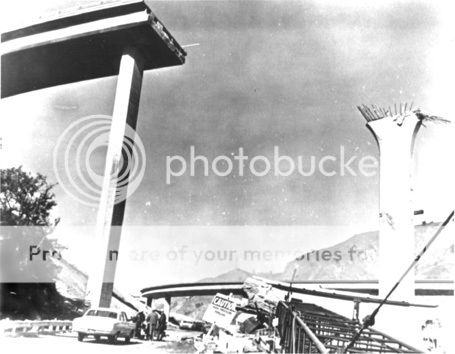
Collapse of I-5 overpass. A similar scene would be repeated in 1994. Author unknown; photograph in public domain.
It was on February 9, 1971, when an earthquake fault not believed to have been a threat unleashed one of the worst damaging earthquakes in modern Southern California, in what became known as The Sylmar Earthquake.
A film by The President's Office of Emergency Preparedness along with The Defense Civil Preparedness Agency, complete with early 1970s PSA dramatic music, on the 1971 earthquake.
Here are six interesting facts about The Sylmar Earthquake you may never have known about.
1 - The 1971 Earthquake Is Holding Up New Development In Hollywood
If you have been following the news concerning new proposed developments of residential and commercial high-rise buildings around the Capital Records building in Hollywood, known as the Millennium Hollywood project, you know the proposed developments are now delayed and ensnared in controversy, because of where The Hollywood Fault may or may not be, and that delay is a result of the 1971 earthquake.
How so?
The Alquist-Priolo Earthquake Fault Zoning Act is causing the holdup and controversy in Hollywood. The Alquist-Priolo Act, according to the California Geological Survey, "is to prevent the construction of buildings used for human occupancy on the surface trace of active faults."
Alquist-Priolo came to be a state law as a result of the 1971 earthquake. The 1971 earthquake showed the destructive power of extensive surface fault ruptures, which damaged many homes and buildings right atop or very near the fault-line. Lawmakers in Sacramento realized this sort of thing will be a problem in the next major earthquake with many buildings already built on or very near faults, and thus a law was created to prevent new construction on and very near earthquake fault-lines. The law also requires real estate agents to inform potential building owners that property they may be thinking of buying is built on or very near a fault-line

As dramatically illustrated in this damaged Sylmar home this is what happens when a building is built on the surface trace of an active fault after that fault ruptures. Photograph by USGS; in public domain.
Today in Hollywood private developers, the City of Los Angeles, the California Geological Survey, private geologists hired by the developers and Hollywood residents opposed to this new development, are all trying to say just where The Hollywood Fault is located. If The Hollywood Fault lays atop one of these proposed projects, as new studies show it just may be, then The Alquist-Priolo Act could prevent a new building in Hollywood from being built.
Not too long ago the California Geological Survey introduced new mapping of The Hollywood Fault.
2 - Two Seconds Made All The Difference
The 1971 earthquake was a massive disaster resulting in collapsed freeways, destroyed homes, and way too many ruined lives. Yet, according to geologists, this disaster was only seconds away from being a really bad disaster to a historic catastrophic disaster.
One of the big stories resulting from the earthquake was the massive evacuation of 80,000 people when the lower Van Norman Dam sustained major damage. With large aftershocks occurring, including a magnitude 5.8 shortly after the mainshock, there was great fear the dam would collapse. So a mass evacuation was underway as engineers, working nearly nonstop, were able to drain part of the dam and save the day.

Severe damage of the lower Van Norman Dam following the earthquake that came perilous close to flooding part of The Valley. Photograph by USGS; in public domain.
Just how close did the Van Norman Dan come to collapsing? According to California Geology, April/May 1971, "Had shaking of the endangered reservoirs continued for 2 seconds more, it has been estimated that there would have been no time to evacuate those below."
Had the shaking gone on for those two seconds more a UCLA study claimed thousands could have been killed if the Van Norman Dam failed.
As a result of this near catastrophic event all dams in California were reevaluated and retrofitted.
The retrofitting did its job as in the Northridge Earthquake the Van Norman Dam had no serious damage.
3 - The Epicenter Was NOT in Sylmar And The Actual Size Of The Quake Really Was...?
While this event that morning in 1971 will forever be known as The Sylmar Earthquake the actual epicenter was in the San Gabriel Mountains above The Valley. Much of the spectacular and devastating damage was in the Sylmar area and "The Sylmar Earthquake" was a name the media latched onto. Much of the same happened in 1994 when it was revealed the actual epicenter was in Reseda rather than Northridge.
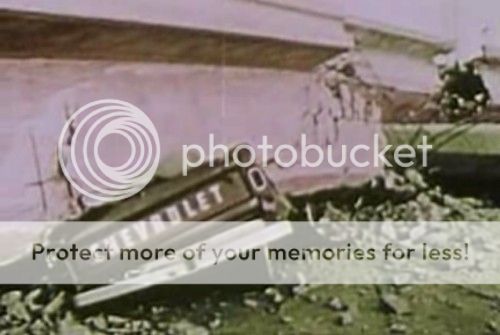
A powerful photograph showing the destructive, deadly force of Mother Nature. This is believed to be the I-210/I-5 interchange, and, sadly, those in Chevrolet did not survive. Author unknown; photograph in public domain.
As for the the actual size of the earthquake, well, the United States Geological Survey puts the magnitude of this earthquake at M6.6, which for all intents and purposes has been deemed the "official magnitude" of The Sylmar Earthquake. However, other institutions, such as universities and geological groups from other countries, have put this earthquake as low as M6.5, and as high as M6.7.
4 - The Charles Manson Trial Continued Just Hours After the Earthquake
On January 27. 1971, in downtown L.A. the jury in the Charles Manson trial returned verdicts of "Guilty" for Mr. Manson and three "family members" for the Tate-LaBianca murders. A few days later the penalty phase commenced, which the jury, who had been sequestered during the trial at The Ambassador Hotel, would decide if Mr. Manson and "the family members" would receive life imprisonment or the death penalty.
On the morning the Earth shook lead prosecutor Vincent Bugliosi, as told in his bestseller book about the trial, Helter Skelter, thought members of "the family" were trying to break into his house with all the shaking and noise going on. That was not an unfounded fear as Mr. Bugliosi, the judge overseeing the trial and many other people involved in The Manson Trial received death threats, and soon had 24-hour protection during the trial.
Schools were closed for the day, as were other businesses (some of that was probably due to the fact dozens of schools and homes were severely damaged), but amazingly, and curiously, for The Manson Trial it was business as usual. What is most amazing about this is the trial was held at the historical Los Angeles County Hall of Justice building, which was deemed unsafe and essentially abandoned immediately right after the 1994 Northridge Earthquake.
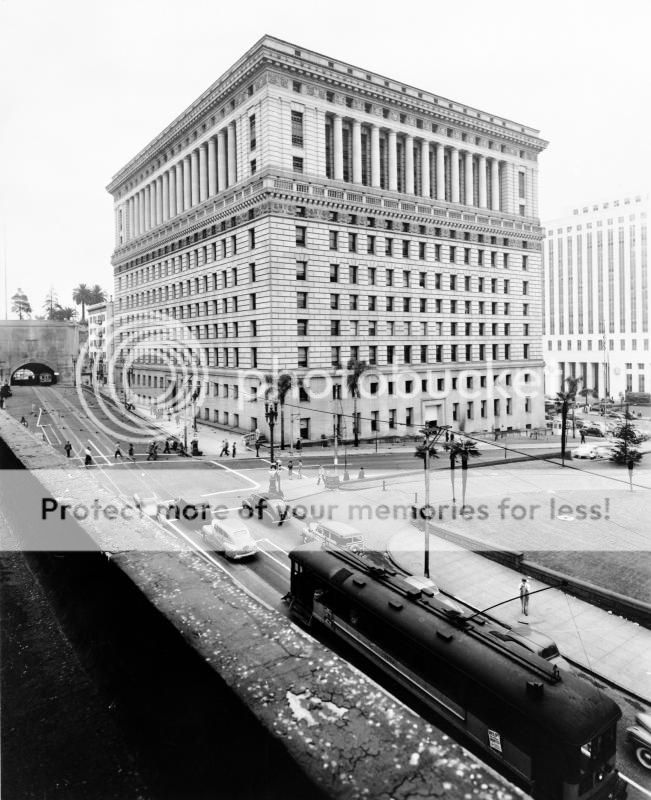
While not a 1971 view of the L.A. County Hall of Justice this photograph, circa 1940, was too good to pass up. Author unknown; photograph in public domain.
The Hall of Justice has been undergoing rehabilitation for a few years, and it is expected to be brought back into service in all its glory in 2015.
5 - A Record We Hope Is Never Broken
One grim statistic of the 1971 earthquake we hope is never broken in the next major Southern California earthquake (yes, there will be a next time) is this, The Sylmar Earthquake had more deaths than the Northridge Earthquake. Thus making it the deadest earthquake in modern L.A. history.
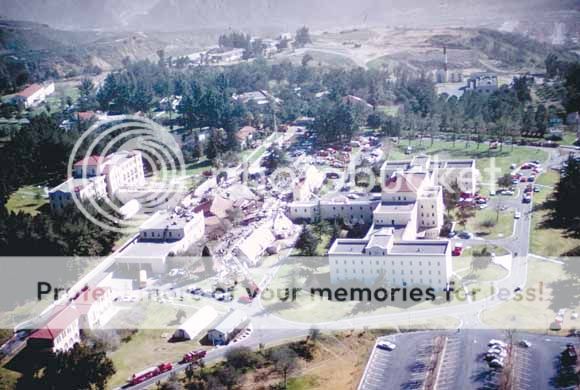
USGS photograph of collapse of San Fernando Veterans Administration Hospital where the majority of earthquake deaths occurred. Photograph in public domain.
The deadliest earthquake in Southern California history was the 1933 Long Beach Earthquake (which actually had an epicenter in Newport Beach).
6 - David Horowitz and Tom Brokaw Were The Lone TV Voices After the Shock
During the shaking power was knocked out, and the sun was not quite out yet, which, like the Northridge Earthquake, brought much of the L.A. Basin into utter darkness. Realizing a major event had just happened, and perhaps being a bit close to the epicenter in Burbank, KNBC reporter David Horowitz (known for his Fight Back segments, and not to be confused with a political pundit of the same name) went outside the darken NBC Studios on Alameda Avenue, and sitting on nothing more than a bar-stool he just began talking about the earthquake to those viewers who's power had not been knocked out (or those watching with those big, bulky portable televisions powered by a half-dozen batteries). Being in a darken lot made for dramatic live television. Joining Mr. Horowitz shortly after he went on the air in that darken Burbank lot was then local KNBC reporter Tom Brokaw. For a time after the earthquake Mr. Horowitz and Mr. Brokaw were providing the only live television coverage of the earthquake.
Mr. Horowitz and Mr. Brokaw attributed much of their early reporting to news reports from radio stations, KFWB, KGIL and KNX.
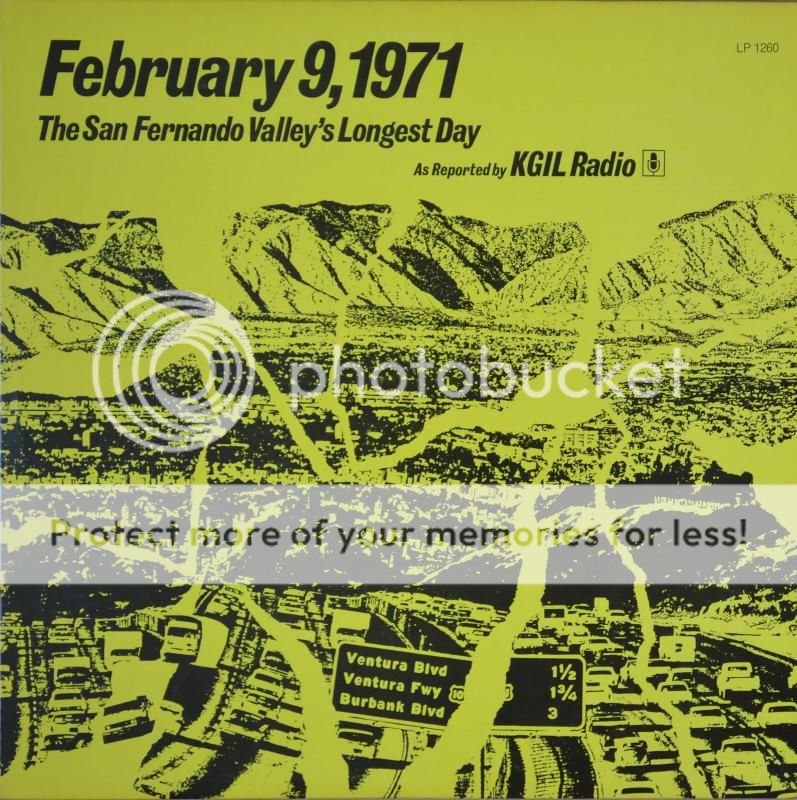
The cover of a LP put out by KGIL, which on 1260 AM was The Valley's radio station, which featured various airchecks of their earthquake coverage on February 9. The album is in limited press and is considered a collectors item.
As odd as it may seem today given the current nature of L.A. television news (where the slightest raindrop brings on "STORM WATCH TEAM COVERAGE"), KNBC and soon thereafter KTLA, which pioneered local breaking news coverage, were really the only local television stations that had continuous coverage of the earthquake. As the Los Angeles Times noted, KNXT and KABC had intermittent updates throughout the morning, and Ralph Story carried on with his morning show as usual only mentioning the earthquake here and there. The Times also wondered where KHJ-TV, KTTV and KCOP news coverage was during this "Day of Disaster" (as the Times' banner front-page headline ran the following day) as they carried on with their usual fare of morning cartoons all while seemingly ignoring one of the biggest disasters in modern L.A. history.

Collapse of I-5 overpass. A similar scene would be repeated in 1994. Author unknown; photograph in public domain.
It was on February 9, 1971, when an earthquake fault not believed to have been a threat unleashed one of the worst damaging earthquakes in modern Southern California, in what became known as The Sylmar Earthquake.
A film by The President's Office of Emergency Preparedness along with The Defense Civil Preparedness Agency, complete with early 1970s PSA dramatic music, on the 1971 earthquake.
Here are six interesting facts about The Sylmar Earthquake you may never have known about.
1 - The 1971 Earthquake Is Holding Up New Development In Hollywood
If you have been following the news concerning new proposed developments of residential and commercial high-rise buildings around the Capital Records building in Hollywood, known as the Millennium Hollywood project, you know the proposed developments are now delayed and ensnared in controversy, because of where The Hollywood Fault may or may not be, and that delay is a result of the 1971 earthquake.
How so?
The Alquist-Priolo Earthquake Fault Zoning Act is causing the holdup and controversy in Hollywood. The Alquist-Priolo Act, according to the California Geological Survey, "is to prevent the construction of buildings used for human occupancy on the surface trace of active faults."
Alquist-Priolo came to be a state law as a result of the 1971 earthquake. The 1971 earthquake showed the destructive power of extensive surface fault ruptures, which damaged many homes and buildings right atop or very near the fault-line. Lawmakers in Sacramento realized this sort of thing will be a problem in the next major earthquake with many buildings already built on or very near faults, and thus a law was created to prevent new construction on and very near earthquake fault-lines. The law also requires real estate agents to inform potential building owners that property they may be thinking of buying is built on or very near a fault-line

As dramatically illustrated in this damaged Sylmar home this is what happens when a building is built on the surface trace of an active fault after that fault ruptures. Photograph by USGS; in public domain.
Today in Hollywood private developers, the City of Los Angeles, the California Geological Survey, private geologists hired by the developers and Hollywood residents opposed to this new development, are all trying to say just where The Hollywood Fault is located. If The Hollywood Fault lays atop one of these proposed projects, as new studies show it just may be, then The Alquist-Priolo Act could prevent a new building in Hollywood from being built.
Not too long ago the California Geological Survey introduced new mapping of The Hollywood Fault.
2 - Two Seconds Made All The Difference
The 1971 earthquake was a massive disaster resulting in collapsed freeways, destroyed homes, and way too many ruined lives. Yet, according to geologists, this disaster was only seconds away from being a really bad disaster to a historic catastrophic disaster.
One of the big stories resulting from the earthquake was the massive evacuation of 80,000 people when the lower Van Norman Dam sustained major damage. With large aftershocks occurring, including a magnitude 5.8 shortly after the mainshock, there was great fear the dam would collapse. So a mass evacuation was underway as engineers, working nearly nonstop, were able to drain part of the dam and save the day.

Severe damage of the lower Van Norman Dam following the earthquake that came perilous close to flooding part of The Valley. Photograph by USGS; in public domain.
Just how close did the Van Norman Dan come to collapsing? According to California Geology, April/May 1971, "Had shaking of the endangered reservoirs continued for 2 seconds more, it has been estimated that there would have been no time to evacuate those below."
Had the shaking gone on for those two seconds more a UCLA study claimed thousands could have been killed if the Van Norman Dam failed.
As a result of this near catastrophic event all dams in California were reevaluated and retrofitted.
The retrofitting did its job as in the Northridge Earthquake the Van Norman Dam had no serious damage.
3 - The Epicenter Was NOT in Sylmar And The Actual Size Of The Quake Really Was...?
While this event that morning in 1971 will forever be known as The Sylmar Earthquake the actual epicenter was in the San Gabriel Mountains above The Valley. Much of the spectacular and devastating damage was in the Sylmar area and "The Sylmar Earthquake" was a name the media latched onto. Much of the same happened in 1994 when it was revealed the actual epicenter was in Reseda rather than Northridge.

A powerful photograph showing the destructive, deadly force of Mother Nature. This is believed to be the I-210/I-5 interchange, and, sadly, those in Chevrolet did not survive. Author unknown; photograph in public domain.
As for the the actual size of the earthquake, well, the United States Geological Survey puts the magnitude of this earthquake at M6.6, which for all intents and purposes has been deemed the "official magnitude" of The Sylmar Earthquake. However, other institutions, such as universities and geological groups from other countries, have put this earthquake as low as M6.5, and as high as M6.7.
4 - The Charles Manson Trial Continued Just Hours After the Earthquake
On January 27. 1971, in downtown L.A. the jury in the Charles Manson trial returned verdicts of "Guilty" for Mr. Manson and three "family members" for the Tate-LaBianca murders. A few days later the penalty phase commenced, which the jury, who had been sequestered during the trial at The Ambassador Hotel, would decide if Mr. Manson and "the family members" would receive life imprisonment or the death penalty.
On the morning the Earth shook lead prosecutor Vincent Bugliosi, as told in his bestseller book about the trial, Helter Skelter, thought members of "the family" were trying to break into his house with all the shaking and noise going on. That was not an unfounded fear as Mr. Bugliosi, the judge overseeing the trial and many other people involved in The Manson Trial received death threats, and soon had 24-hour protection during the trial.
Schools were closed for the day, as were other businesses (some of that was probably due to the fact dozens of schools and homes were severely damaged), but amazingly, and curiously, for The Manson Trial it was business as usual. What is most amazing about this is the trial was held at the historical Los Angeles County Hall of Justice building, which was deemed unsafe and essentially abandoned immediately right after the 1994 Northridge Earthquake.

While not a 1971 view of the L.A. County Hall of Justice this photograph, circa 1940, was too good to pass up. Author unknown; photograph in public domain.
The Hall of Justice has been undergoing rehabilitation for a few years, and it is expected to be brought back into service in all its glory in 2015.
5 - A Record We Hope Is Never Broken
One grim statistic of the 1971 earthquake we hope is never broken in the next major Southern California earthquake (yes, there will be a next time) is this, The Sylmar Earthquake had more deaths than the Northridge Earthquake. Thus making it the deadest earthquake in modern L.A. history.

USGS photograph of collapse of San Fernando Veterans Administration Hospital where the majority of earthquake deaths occurred. Photograph in public domain.
The deadliest earthquake in Southern California history was the 1933 Long Beach Earthquake (which actually had an epicenter in Newport Beach).
6 - David Horowitz and Tom Brokaw Were The Lone TV Voices After the Shock
During the shaking power was knocked out, and the sun was not quite out yet, which, like the Northridge Earthquake, brought much of the L.A. Basin into utter darkness. Realizing a major event had just happened, and perhaps being a bit close to the epicenter in Burbank, KNBC reporter David Horowitz (known for his Fight Back segments, and not to be confused with a political pundit of the same name) went outside the darken NBC Studios on Alameda Avenue, and sitting on nothing more than a bar-stool he just began talking about the earthquake to those viewers who's power had not been knocked out (or those watching with those big, bulky portable televisions powered by a half-dozen batteries). Being in a darken lot made for dramatic live television. Joining Mr. Horowitz shortly after he went on the air in that darken Burbank lot was then local KNBC reporter Tom Brokaw. For a time after the earthquake Mr. Horowitz and Mr. Brokaw were providing the only live television coverage of the earthquake.
Mr. Horowitz and Mr. Brokaw attributed much of their early reporting to news reports from radio stations, KFWB, KGIL and KNX.

The cover of a LP put out by KGIL, which on 1260 AM was The Valley's radio station, which featured various airchecks of their earthquake coverage on February 9. The album is in limited press and is considered a collectors item.
As odd as it may seem today given the current nature of L.A. television news (where the slightest raindrop brings on "STORM WATCH TEAM COVERAGE"), KNBC and soon thereafter KTLA, which pioneered local breaking news coverage, were really the only local television stations that had continuous coverage of the earthquake. As the Los Angeles Times noted, KNXT and KABC had intermittent updates throughout the morning, and Ralph Story carried on with his morning show as usual only mentioning the earthquake here and there. The Times also wondered where KHJ-TV, KTTV and KCOP news coverage was during this "Day of Disaster" (as the Times' banner front-page headline ran the following day) as they carried on with their usual fare of morning cartoons all while seemingly ignoring one of the biggest disasters in modern L.A. history.